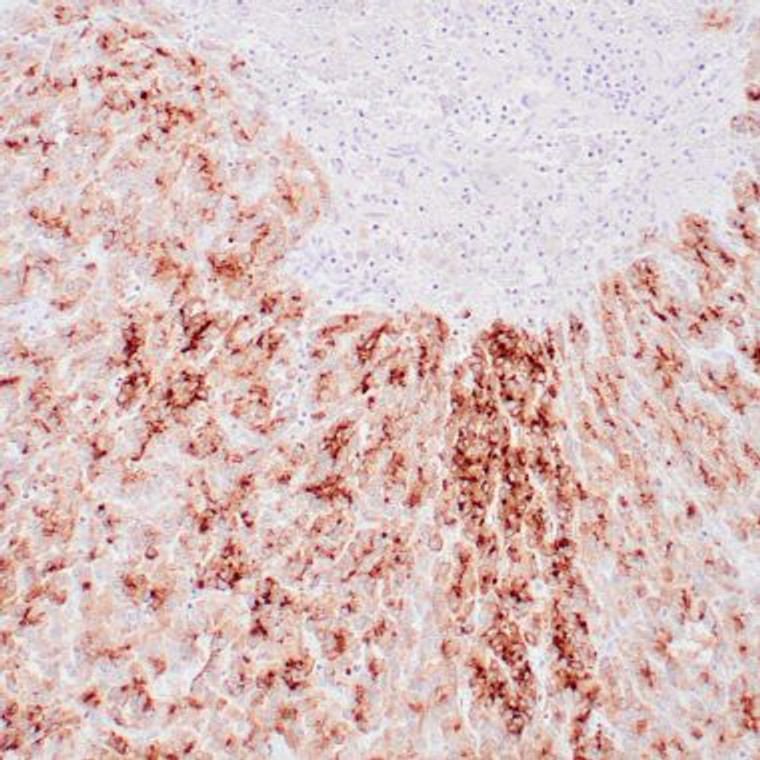| Host: |
Mouse |
| Applications: |
IHC-P |
| Reactivity: |
Human |
| Note: |
STRICTLY FOR FURTHER SCIENTIFIC RESEARCH USE ONLY (RUO). MUST NOT TO BE USED IN DIAGNOSTIC OR THERAPEUTIC APPLICATIONS. |
| Short Description: |
Mouse monoclonal antibody anti-GPC3 (C-term 70aa) is suitable for use in Immunohistochemistry research applications. |
| Clonality: |
Monoclonal |
| Clone ID: |
1G12 |
| Conjugation: |
Unconjugated |
| Isotype: |
IgG1/Kappa |
| Formulation: |
Tris-HCI buffer containing stabilizing protein (BSA) and <0.1% ProClin |
| Purification: |
Affinity purified |
| Dilution Range: |
1:100‐200 |
| Storage Instruction: |
Store at 2‐8°C for up to 24 months. Predilute: Ready to use, no reconstitution necessary. Concentrate: Use dilution range and appropriate lab‐standardized diluent. Stability after dilution: 7 days at 24°C, 3 months at 2‐8°C, 6months at ‐20°C. |
| Gene Symbol: |
GPC3 |
| Gene ID: |
2719 |
| Uniprot ID: |
GPC3_HUMAN |
| Immunogen Region: |
C-term 70aa |
| Specificity: |
Positive control: Hepatocellular carcinoma |
| Immunogen: |
A fragment containing the last 70 amino acids of the core glypican-3 protein |
| Tissue Specificity | Detected in placenta (at protein level). Highly expressed in lung, liver and kidney. |
| Post Translational Modifications | O-glycosylated.contains heparan sulfate and/or chondroitin sulfate. Cleaved intracellularly by a furin-like convertase to generate 2 subunits, alpha and beta, which remain associated through disulfide bonds and are associated with the cell surface via the GPI-anchor. This processing is essential for its role in inhibition of hedgehog signaling. A second proteolytic event may result in cleavage of the protein on the cell surface, separating it from the GPI-anchor and leading to its shedding from the cell surface. |
| Function | Cell surface proteoglycan. Negatively regulates the hedgehog signaling pathway when attached via the GPI-anchor to the cell surface by competing with the hedgehog receptor PTC1 for binding to hedgehog proteins. Binding to the hedgehog protein SHH triggers internalization of the complex by endocytosis and its subsequent lysosomal degradation. Positively regulates the canonical Wnt signaling pathway by binding to the Wnt receptor Frizzled and stimulating the binding of the Frizzled receptor to Wnt ligands. Positively regulates the non-canonical Wnt signaling pathway. Binds to CD81 which decreases the availability of free CD81 for binding to the transcriptional repressor HHEX, resulting in nuclear translocation of HHEX and transcriptional repression. Inhibits the dipeptidyl peptidase activity of DPP4. Plays a role in limb patterning and skeletal development by controlling the cellular response to BMP4. Modulates the effects of growth factors BMP2, BMP7 and FGF7 on renal branching morphogenesis. Required for coronary vascular development. Plays a role in regulating cell movements during gastrulation. |
| Protein Name | Glypican-3Gtr2-2Intestinal Protein Oci-5Mxr7 Cleaved Into - Glypican-3 Alpha Subunit - Glypican-3 Beta Subunit |
| Database Links | Reactome: R-HSA-1971475Reactome: R-HSA-2022928Reactome: R-HSA-2024096Reactome: R-HSA-3560783Reactome: R-HSA-3560801Reactome: R-HSA-3656237Reactome: R-HSA-3656253Reactome: R-HSA-381426Reactome: R-HSA-4420332Reactome: R-HSA-8957275Reactome: R-HSA-9694614Reactome: R-HSA-975634 |
| Cellular Localisation | Cell MembraneLipid-AnchorGpi-AnchorExtracellular Side |
| Alternative Antibody Names | Anti-Glypican-3 antibodyAnti-Gtr2-2 antibodyAnti-Intestinal Protein Oci-5 antibodyAnti-Mxr7 Cleaved Into - Glypican-3 Alpha Subunit - Glypican-3 Beta Subunit antibodyAnti-GPC3 antibodyAnti-OCI5 antibody |
Information sourced from Uniprot.org
12 months for antibodies. 6 months for ELISA Kits. Please see website T&Cs for further guidance





